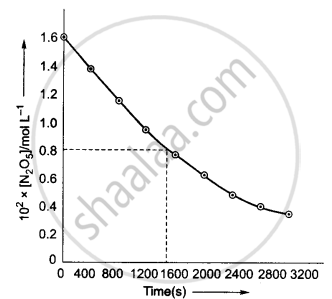Advertisements
Advertisements
प्रश्न
The experimental data for decomposition of N2O5
\[\ce{2N2O5 -> 4NO2 + O2}\] in gas phase at 318K are given below:
| t/s | 0 | 400 | 800 | 1200 | 1600 | 2000 | 2400 | 2800 | 3200 |
| 102 × [N2O5]/mol L−1 | 1.63 | 1.36 | 1.14 | 0.93 | 0.78 | 0.64 | 0.53 | 0.43 | 0.35 |
- Plot [N2O5] against t.
- Find the half-life period for the reaction.
- Draw a graph between log [N2O5] and t.
- What is the rate law?
- Calculate the rate constant.
- Calculate the half-life period from k and compare it with (ii).
उत्तर
(i)

(ii) Initial concentration of N2O5 = 1.63 × 10−2 M
Half of this concentration = 0.815 × 10−2 M
The time corresponding to M concentration = 1440 s
Hence, `t_(1/2)` = 1440 s
(iii)
| t/s | [N2O5] × 102/mol L−1 | log [N2O5] |
| 0 | 1.63 | −1.79 |
| 400 | 1.36 | −1.87 |
| 800 | 1.14 | −1.94 |
| 1200 | 0.93 | −2.03 |
| 1600 | 0.78 | −2.11 |
| 2000 | 0.64 | −2.19 |
| 2400 | 0.53 | −2.28 |
| 2800 | 0.43 | −2.37 |
| 3200 | 0.35 | −2.46 |

(iv) The given reaction is of the first order as the plot, log [N2O5] v/s t, is a straight line. Therefore, the rate law of the reaction is:
Rate = k[N2O5]
(v) For first order reaction,
log R = `- k/2.303t + logR_0`
Therefore the slope of the graph drawn between log R and t will be `(-k)/2.303`
∴ The slope of the line = `-k/2.303`
= `(y_2 - y_1)/(t_2 - t_1)`
= `(-2.46 - (-1.79))/(3200 - 0)`
= `-0.67/3200`
∴ k = 4.82 × 10−4 s−1
(vi) Half-life is given by,
`t_(1/2) = 0.639/k`
= `0.693/(4.82xx10^(-4))`
= 1.438 × 103 s
= 1438 s
This value, 1438 s, is very close to the value that was obtained from the graph.
APPEARS IN
संबंधित प्रश्न
Derive the relation between half life and rate constant for a first order reaction
A first order reaction takes 40 minutes for 30% decomposition. Calculate t1/2 for this reaction. (Given log 1.428 = 0.1548)
The half-life for radioactive decay of 14C is 5730 years. An archaeological artifact containing wood had only 80% of the 14C found in a living tree. Estimate the age of the sample.
During nuclear explosion, one of the products is 90Sr with half-life of 28.1 years. If 1μg of 90Sr was absorbed in the bones of a newly born baby instead of calcium, how much of it will remain after 10 years and 60 years if it is not lost metabolically.
Which among the following reactions is an example of a zero order reaction?
a) `H_(2(g)) + I_(2(g)) -> 2HI_(g)`
b) `2H_2O_(2(l)) -> 2H_2O_(l) + O_(2(g))`
c) `C_12H_22O_(11(aq)) + H_2O_(l) -> C_6H_12O_(6(aq)) + C_6H_12O_(6(aq))`
d) `2NH_(3g)` `N(2g) + 3H_(2(g))`
A first order reaction takes 10 minutes for 25% decomposition. Calculate t1/2 for the reaction.
(Given : log 2 = 0.3010, log 3 = 0.4771, log 4 = 0.6021)
The half life period of a radioactive element is 140 days. After 560 days, 1 g of element will be reduced to
Define half life of a reaction.
For the first order reaction, half-life is equal to ____________.
Calculate half-life period of life order reaction whose rate constant is 200 sec–1
Half life (t1/2) and completion time (T) of the zero order reaction are- (K = 0.001 mol/litre/sec and a = 1 M.)
The half-life of cobalt 60 is 5.26 years. The percentage activity remaining after 4 years is ______%.
The amount of C-14 isotope in a piece of wood is found to be 1/16th of its amount present in a fresh piece of wood. The age of wood, half-life period of C-14 is 5770 years, is ______ years.
Obtain a relation, `k_2/k_1 = ((t_(1/2))_2)/((t_(1/2))_1)`, where k1 and k2 are rate constants while (t1/2)1 and (t1/2)2 are half-life periods of the first order reaction at temperatures T1 and T2 respectively. Write the relation for activation energy.
The half-lives of a first-order reaction are 1.19s at 313 K and 15.45s at 293 K. Calculate the energy of activation.
The unit of rate constant of zero order reaction is ______.
Show that the half-life of zero order reaction is `t_(1/2) = ([A]_0)/(2k)`.
Calculate the half-life of a first order reaction from the rate constant given below:
4 year−1
